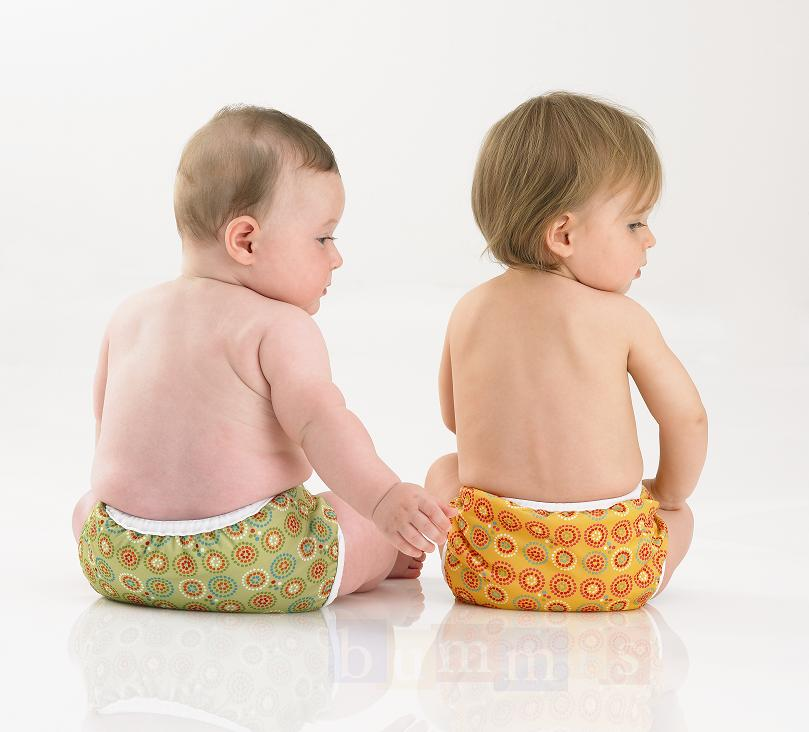Cloth Diapering Milestones: Moving from Liquids to Solids
Posted on November 07, 2011

It may seem from our title that we're talking about food today, but as is inevitable in any conversation about diapers, today we're actually discussing
poo. (Sorry if we got your hopes up....) As any pediatrician or naturopath will tell you, watching your infant's stools change from liquid to solid is an important, significant transition, and sometimes that can mean changing your diaper selection as well.
The Newborn Days
In the early days of life, your baby's gut is immature. For the first few days, it's excreting all the lovely, tarry
meconium that is a by-product of life in the womb, and for the first few weeks is incapable of holding food for long. And obviously, the only food intake is in liquid form, so with all these factors together, you can count on a liquid-y, poopy diaper after every meal. (
Diaper liners are a welcome accessory during this period!)
As for color and texture, due to the colonization of the gut with all the good bacteria it needs for nutrient absorption, you can watch the stool go from black to various shades of yellow and green. Your doctor or midwife will likely ask you at some point about the stool's color and consistency as an indication of the baby's health, especially if the baby has been jaundiced.
In terms of diapering, all of this liquid stool in the early days means that the most important factor to consider in choosing diapers is
containment. You need a diaper or a cover that has good, snug elastic around the legs and waist to keep all the poo exactly where it belongs. Popular choices from New & Green parents tend to be a
prefold, Snappi, and cover combo, a
Kissaluvs size 0 +
cover combo, and the (super cute)
TiniFit All-in-One.
Regularity
At about 6-8 weeks of age, your baby's stools will begin to change. While at the beginning poo tends to be runny, at this point it will begin to hold together and take on a firmer, more tacky texture. The upside to this is that the stool can be easier to shake off into the toilet, as well as that food is now moving more slowly through the gut, so it's entirely possible that your baby will only move his or her bowels once or twice a day, sometimes at the same time each day. (Wahoo!) And as the months go by and as your baby begins to eat solid food, the poo will continue to solidify.
So as poo becomes more - shall we say,
regular - containment is no longer the highest priority for a diaper, but
absorbancy. Poo may not be as frequent, but the baby's bladder is getting bigger and he or she is eating more.
Thus, parents' favorite diapers tend to change: many still love the
prefold + cover combo and the
EasyFit All-in-One, but other favorites for this period include the
Bamboozle bamboo fitted, the
AMP hemp fitted, and
BumGenius pocket diapers.
Watching your baby grow and change can be an incredible, joyful experience. We certainly hope that cloth diapering on that journey helps you celebrate the joy of watching your child grow and seeing the miracle of all the changes that your baby's body goes through, including the myriad type of messy diapers.
And care to share
your experiences? We welcome hearing your stories about how you have dealt with your "poo problems," as questions about how to deal with poop are among our most frequent at our
Cloth Diapering 101 workshops and here on the
blog. Real-life stories are fantastic!
Previous: Eucalan No Rinse Wool Wash
 It may seem from our title that we're talking about food today, but as is inevitable in any conversation about diapers, today we're actually discussing poo. (Sorry if we got your hopes up....) As any pediatrician or naturopath will tell you, watching your infant's stools change from liquid to solid is an important, significant transition, and sometimes that can mean changing your diaper selection as well.
It may seem from our title that we're talking about food today, but as is inevitable in any conversation about diapers, today we're actually discussing poo. (Sorry if we got your hopes up....) As any pediatrician or naturopath will tell you, watching your infant's stools change from liquid to solid is an important, significant transition, and sometimes that can mean changing your diaper selection as well.






